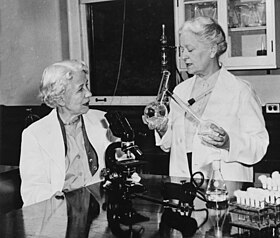Rachel Fuller Brown
| Rachel Fuller Brown | |
|---|---|

Elizabeth Lee Hazen and Brown (right)
|
|
| Born |
23 November 1898 Springfield, Massachusetts |
| Died | 14 January 1980 (aged 81) Albany, New York |
| Nationality | United States |
| Fields |
Organic chemistry bacteriology |
| Alma mater | University of Chicago |
| Known for | Co-discovery of antifungal agent nystatin with Elizabeth Lee Hazen |
| Notable awards | Quibb Award in Chemotherapy (1955) Rhoda Benham Award of the Medical Mycological Society of the Americas (1972) American Institute of Chemists’ Chemical Pioneer Award (1975) National Inventors Hall of Fame Inductee (1994) |
Rachel Fuller Brown (November 23, 1898 – January 14, 1980) was a chemist best known for her long-distance collaboration with microbiologist Elizabeth Lee Hazen in developing the first useful antifungal antibiotic, nystatin, while doing research for the Division of Laboratories and Research of the New York State Department of Health. Brown received her B.A. from Mount Holyoke College and her Ph.D from the University of Chicago. She was inducted into the National Inventors Hall of Fame in 1994.
Nystatin, still produced today under various trade names, not only cures a variety of potentially devastating fungal infections, but has also been used to combat Dutch Elm disease in trees and to restore artwork damaged by water and mold.
Rachel Fuller Brown was born on November 23, 1898 in Springfield, Massachusetts to parents George Hamilton Brown, a real estate and insurance agent, and Annie Fuller, a director of religious education. They later moved to Missouri where, at the age of fourteen, Brown’s parents separated and her father left the family with almost no money. So her family of three moved back to Springfield.
Upon the family’s return to Springfield, Rachel enrolled in Commercial High School, but her mother forced her to transfer to Central High School for a more traditional education.
Brown’s hard work and determination to go to college impressed Henriette F. Dexter, a friend of her grandmother, who decided to pay for Brown to attend Mount Holyoke College. Though she originally chose to major in history, she fell in love with chemistry, a strong field at Mount Holyoke, after taking a required science course taught by Emma P. Carr. Brown earned her B.A. in chemistry and history in 1920.
After working as a laboratory assistant for some time, Brown eventually began her graduate work and earned an M.S. in organic chemistry from the University of Chicago in 1921. She then taught for three years at the Frances Shimer School near Chicago, a school and junior college for girls (now known as Shimer College).
After taking some language courses and chemistry at Harvard, Brown returned to the University of Chicago for additional graduate work in organic chemistry and bacteriology. After successfully completing her research project and the required course work in 1926, she submitted her Ph.D thesis. However, due to some complications in scheduling her oral examinations and the depletion of her savings, Brown was forced to leave Chicago without her Ph.D to find a job at the Division of Laboratories and Research in Albany, New York.
...
Wikipedia
